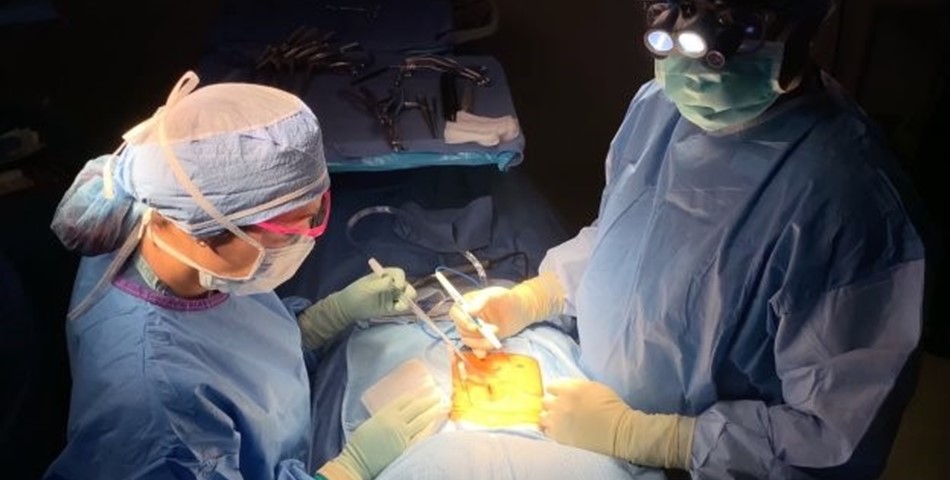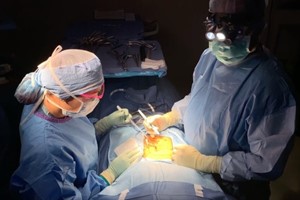Advances in microtechnology have influenced the orthopedic surgeon’s ability to perform knifeless, bloodless, ultra-precise minimally invasive spine surgery.
Many surgeons seek strategies that enable them to better perform surgical procedures and treat patients. The future is now. In the OR, spine surgeons use key strategies, including bloodless surgery, minimally invasive surgery, advanced bone grafting techniques that involve using recombinant human bone morphogenetic protein, harvesting stem cells for intraoperative use, using spinal navigation to assess instrumentation placement, using intraoperative CT scans and ultra-modern OR tables, as well as performing spinal cord and nerve monitoring. A microdissection needle is one such advance.
The microdissection needle is standardly used in head and neck surgery and surgery that requires precise incisions with minimal scarring. Facing an extremely difficult surgical upper cervical approach in a massive patient, we combined services for the surgical approach during which time Al Shetawi introduced Hansraj to use of a microdissection needle, which is a surgical electrocautery tool. Hansraj has continually used this needle since then.
Knifeless skin incisions
A microdissection needle provides the opportunity to make a skin incision without a standard steel knife. The tool consists of a 5 µm tip, which creates high-density current for hemostasis or blood control at low power settings (5 µm = 0.005mm = 0.0002 inches). The typical width of a surgical blade is 0.36 mm, which is 72-times larger than a microdissection needle.
Lower watts of electricity
Typically, the skin incision is made with the microdissection needle set at 10 watts. Deeper incision at the level of the fascia is performed at 20 watts. Deepest spine incisions are conducted at 30 watts. The microdissection needle provides a unique opportunity to stop bleeding in minimally invasive ports. For example, during kyphoplasty surgery, the size of the approach entrances is 2 mm and these can be precisely made by the needle. If there is bleeding during conventional surgical treatment, a suture may be required. However, a microdissection needle is apt at stopping any bleeding from small port holes. Therefore, there may be no need for a suture in cases when this needle is used.
Minimally invasive spine surgery
Using a microdissection needle allows for more precise dissections. Typically, spinal needles are placed before surgery to mark the location of the spinal vertebral bodies as identified by intraoperative radiographs. Using the microdissection needle affords the surgeon the opportunity to operate between needles. Smaller incisions are achieved by tugging the skin proximal and distal, allowing for greater visibility of the operative site.
Bloodless spine surgery
A microdissection or electrocautery needle routinely leads to significantly less blood loss. The ultrafine, ultraprecise needle helps stop blood vessels in an efficient and delicate manner. With a conventional surgical technique, when revision and removal a standard lumbar scar from an old operation takes place, it is not unusual for the patient to lose 300 mL of blood. With a microdissection needle, no blood is lost. Similarly, with the conventional technique, massive redo reoperations routinely cause blood loss that exceeds 1,000 mL. With a microdissection needle, many of these approaches may be associated with only about 100 mL of blood loss. In our experience, the collective savings of blood, especially from massive redo surgeries, is in the tens of thousands of milliliters of blood loss. This is in addition to a careful blood conservation practice.
Academic-based safety
The microdissection needle has been studied by numerous academic bodies. In addition to spine surgery, it has been found to be safe and effective in neurosurgery, craniomaxillofacial surgery, periodontal surgery, upper and lower lid blepharoplasty, hypospadias repair and tonsillectomies.
Kenneth K. Hansraj, MD
drken@drken.us
Al Haitham Al Shetawi, MD, DMD, FACS
halshetawi@gmail.com













